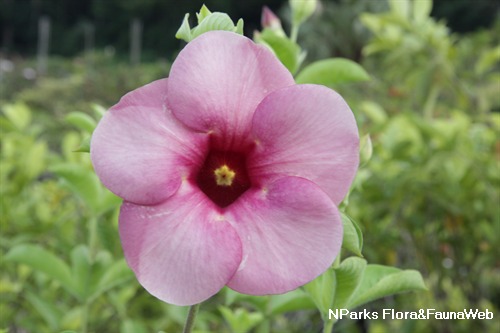
Back
Allamanda cathartica 'Stansill's Double'
| Family Name: | Apocynaceae |
| Common Name: | Double-petalled Golden Trumpet, Double-petalled Yellow Allamanda |
Allamanda cathartica 'Stansill's Double' is a beautiful tropical climber with double-petalled golden yellow trumpet-shaped flowers. It can be trained into shrub and makes an ideal choice for parks and gardens with its glossy green leaves creating a wonderful backdrop for the large and showy cluster of flowers.
Name
Classifications and Characteristics
| Plant Division | Angiosperms (Flowering Seed Plants) (Dicotyledon) |
|---|---|
| Plant Growth Form | Climber, Shrub |
| Lifespan (in Singapore) | Perennial |
| Mode of Nutrition | Autotrophic |
| Maximum Height | 3 m to 6 m |
| Maximum Plant Spread / Crown Width | 1 m to 2 m |
Biogeography
| Native Habitat | Terrestrial |
|---|---|
| Preferred Climate Zone | Tropical |
| Local Conservation Status | Non-native (Horticultural / Cultivated Only) |
Description and Ethnobotany
| Growth Form | A vine plant which has golden yellow double petals; shiny and glossy green leaves. |
|---|---|
| Foliage | Leaves are shiny green, simple, arranged in whorls of 3 or 4 along the stems, elongated shape, prominent mid vein, hairless, petiolate, leathery, contain latex (milky sap). |
| Stems | Stems are hairless, older stems are woody and brownish, while younger stems are greenish. Milky sap present. |
| Flowers | Yellow, funnel-shaped, double form of petals |
| Fruit | Rarely seen in cultivation. |
| Cultivation | This plant flowers best under full sun. It can be trained as shrub or grown as hedge. Occasional pruning is required to promote air circulation to reduce fungal attack on leaves. |
| Etymology | The genus Allamanda is given after Dr. Frederick Allamand. The specific epithet cathartica means cathartic, cleansing, purging which refers to its medicinal purpose in inducing vomiting. |
Landscaping Features
| Desirable Plant Features | Ornamental Flowers |
|---|---|
| Landscape Uses | Suitable for Roadsides, Parks & Gardens, Hedge / Screening |
| Thematic Landscaping | Golden Garden |
| Usage Hazard - Cons | Irritant - Sap, Toxic Upon Ingestion |
Fauna, Pollination and Dispersal
| Fauna Pollination Dispersal Associated Fauna | Bee-Attracting, Bird-Attracting (Flowers), Butterfly-Attracting |
|---|---|
| Pollination Method(s) | Biotic (Fauna) (Insects (Bee)) |
| Seed or Spore Dispersal | Abiotic (Explosive Dehiscence) |
Plant Care and Propagation
| Light Preference | Full Sun |
|---|---|
| Water Preference | Moderate Water |
| Plant Growth Rate | Moderate |
| Rootzone Tolerance | Well-Drained Soils |
| Pest(s) | Sucking Insects |
| Propagation Method | Seed, Stem Cutting |
Foliar
| Foliage Retention | Evergreen |
|---|---|
| Mature Foliage Colour(s) | Green |
| Mature Foliage Texture(s) | Glossy / Shiny |
| Prominent Young Flush Colour(s) | Green |
| Young Flush Texture(s) | Glossy / Shiny |
| Foliar Type | Simple / Unifoliate |
| Foliar Arrangement Along Stem | Opposite, Whorled |
| Foliar Attachment to Stem | Petiolate |
| Foliar Shape(s) | Non-Palm Foliage (Lanceolate, Oblong) |
| Foliar Venation | Pinnate / Net |
| Foliar Margin | Entire - Wavy / Undulate |
| Foliar Apex - Tip | Acuminate |
| Foliar Base | Acute |
Non - Foliar and Storage
| Stem Type & Modification | Woody |
|---|---|
| Root Type | Underground |
Floral (Angiosperm)
| Flower & Plant Sexuality | Bisexual Flowers |
| Flower Colour(s) | Yellow / Golden |
|---|---|
| Flower Texture(s) | Smooth |
| Flower Grouping | Cluster / Inflorescence |
| Flower Location | Axillary |
| Flower Symmetry | Radial |
| Individual Flower Shape | Trumpet-shaped |
| Inflorescence Type | Cyme |
| Flowering Period | Free-Flowering |
| Flowering Habit | Polycarpic |
Fruit, Seed and Spore
| Mature Fruit Colour(s) | Black |
|---|---|
| Mature Fruit Texture(s) | Thorny / Spiny |
| Fruit Classification | Simple Fruit |
| Fruit Type | |
| Mature Seed Colour(s) | Brown |
Image Repository
Others
| Master ID | 8 |
|---|---|
| Species ID | 1304 |
| Flora Disclaimer | The information in this website has been compiled from reliable sources, such as reference works on medicinal plants. It is not a substitute for medical advice or treatment and NParks does not purport to provide any medical advice. Readers should always consult his/her physician before using or consuming a plant for medicinal purposes. |







